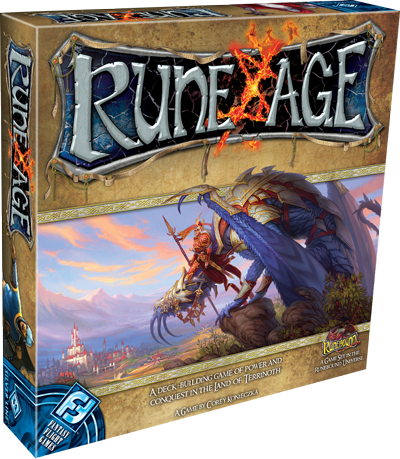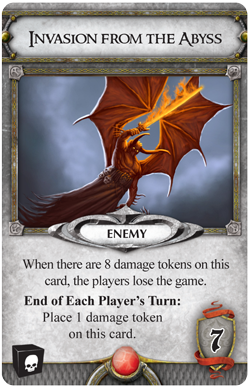Uno de los DeckBuilder, que más interés me ha suscitado, es este RuneAge, ambientado en los mundos de Terrinoth y que viene de la mano de FFG.
Cada cierto tiempo, FFG nos va soltando más información de las mecánicas e imágenes de las cartas.
La verdad es que por lo poco que leo, me va gustando la idea del juego, parece mucho más interactivo entre jugadores que Dominion o Thunderstone. La pena es que de momento Edge no se ha pronunciado sobre si lo distribuirá en España traducido.
As the great races of Terrinoth greedily squabble and skirmish for control of the powerful dragon runes, a far more ancient and terrible power plots the destruction of their world. The end is nigh. Prophecies are coming to pass, and the signs of the end times have begun manifesting themselves. The armies of human, elf, undead, and Uthuk must set aside their petty differences and unite to stand against the calamities that are threatening all of Terrinoth.
 The release of Rune
Age, the versatile deck-building card game set in the fantasy realm of
Terrinoth, grows ever nearer. So far, we’ve looked at the benefits of
its scenario-based design and seen its fast-paced
combat system. At the same time, we’ve seen the widely different play
experiences offered by Rune Age’s first two scenarios, Resurgence of
the Dragonlords and Runewars. Today, we’ll continue our tour of these
flexible modes of play with a look at a fully cooperative (or even solo!)
scenario: The Cataclysm.
The release of Rune
Age, the versatile deck-building card game set in the fantasy realm of
Terrinoth, grows ever nearer. So far, we’ve looked at the benefits of
its scenario-based design and seen its fast-paced
combat system. At the same time, we’ve seen the widely different play
experiences offered by Rune Age’s first two scenarios, Resurgence of
the Dragonlords and Runewars. Today, we’ll continue our tour of these
flexible modes of play with a look at a fully cooperative (or even solo!)
scenario: The Cataclysm.As we’ve seen, Resurgence of the Dragonlords (the first scenario) offers a balance of direct player interaction and individual objectives. Runewars (the second scenario) ratchets up the hostility, pitting the great races directly against each other and making player elimination the means to victory. The Cataclysm, however, takes the opposite approach. Players must work together, since if any one player is eliminated, everyone loses!
A series of unfortunate events
An Objective card (like the one to the right) outlines the players’ victory condition for a given scenario. In The Cataclysm, players are tasked with the goal of surviving through the entire Event deck, but with the unforgiving circumstances that will be assaulting them each round, merely staying alive is a challenge. Event cards are drawn at the start of each round, and they often bring unwelcome changes to the game environment.
As you can see on the three Event cards below, red orbs indicate the “stage” in which an event might potentially transpire. The Cataclysm is a three-stage scenario, meaning that Event cards from all three stages are shuffled in three separate stacks, then those stacks are compiled to form an Event deck that will get progressively more brutal as the game progresses.
Invasion from the Abyss, for example, represents an enemy that places a new “timer” on the game. You or one of your allies had better muster the strength to assault this common foe, or you’ll never even make it into the climactic final rounds of play! Cards like Plague of Vermin force all players to make the difficult choice of either limiting their options (by sending cards from their hands back to the pile from which they were acquired) or taking damage. If you should make it to the third stage, you’ll even encounter Event cards designed to reverse your progress; Master of the Hunt is an enemy that adds Event cards back into the Event deck. But which of you will be strong enough to bring his reign of terror to an end?
Communication is Key
The team that faces The Cataclysm without a plan isn’t likely to succeed. In addition to the faction-specific cards available to each race, three neutral cards, available to anyone, are placed in the center of the table. But if each player pursues an individual strategy, acquiring cards based only on their benefit to his deck, then the team will surely fail. After all, there are a limited number of “Pillage” cards available. Should they be divided evenly? Or should they be added to a single player’s deck, putting that player in a support role for the rest of the team?
Want a bit of treachery in your cooperative efforts? At the start of the game, players can optionally agree to shuffle Brother Against Brother, an instant-effect Event card, into the third stage of the Event deck. This devious card presents each player with a choice in the late game: Are things going well for his uneasy alliance, or should he attempt to claim victory on his own? More importantly, what if he attacks an ally (revealing his traitorous intentions) but his siege is a failure?
Face Judgement Day alone
While a fully cooperative deck-building game presents obvious benefits, Rune Age can also be adapted for solo play. A lone player can choose his favorite faction, then face either The Cataclysm or the Resurgence of the Dragonlords (with just a few minor setup tweaks). This means that you can practice your strategies for your next game night, or save Terrinoth without having to gather your gaming group.
Keep checking back for more on Rune Age, and look for it on store shelves in the third quarter of 2011!
























0 comentarios :
Dí lo que piensas...